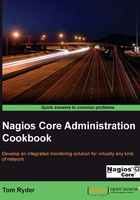
Preface
Nagios Core, the open source version of the Nagios monitoring framework, is an industry standard for network monitoring hosted on Unix-like systems, such as GNU/Linux or BSD. It is very often used by network and system administrators for checking connectivity between hosts and ensuring that network services are running as expected.
Where home-grown scripts performing network checks can rapidly become unmaintainable and difficult for newer administrators to customize safely, Nagios Core provides a rigorous and configurable monitoring framework to make checks in a consistent manner and to alert appropriate people and systems of any problem it detects.
This makes Nagios Core a very general monitoring framework rather than an out-of-the-box monitoring solution, which is known to make it a little unfriendly to beginners and something of a "black box", even to otherwise experienced administrators. Busy administrators charged with setting up a Nagios Core system will often set it up to send PING requests to a set of hosts every few minutes and send them an e-mail about any problem, and otherwise never touch it. More adventurous administrators new to the system might instate a few HTTP checks to make sure that company websites respond.
Nagios Core is capable of a great deal more than that, and this book's recipes are intended to highlight all of the different means of refining and controlling checks, notifications, and reporting for Nagios Core, rather than being a list of instructions for using specific plugins, of which there are many hundreds available online at the Nagios Exchange at http://exchange.nagios.org/. The book's fundamental aim is to get administrators excited about the possibilities of Nagios Core beyond elementary default checking behavior, so that they can use much more of the framework's power, and make it into the centerpiece of their network monitoring.
This also includes installing and even writing custom plugins beyond the standard Nagios Plugins set, writing and refining one's own checks, working with the very powerful Simple Network Management Protocol (SNMP), recording and reporting of performance data, refining notification behavior to only send appropriate notifications at appropriate times to appropriate people or systems, basic visualization options, identifying breakages in network paths, clever uses of the default web interface, and even extending Nagios Core with other open source programs, all in order to check virtually any kind of host property or network service on any network.
Where possible, this book focuses on add-ons written by the Nagios team themselves, particularly NRPE and NSCA. It omits discussion of the popular NRPE replacement check_mk, and of popular forks of Nagios Core such as Icinga. In the interest of conferring an in-depth understanding of advanced Nagios Core configuration, it also does not discuss any configuration frontends or wizards such as NConf. Finally, as a Packt open source series book focusing on the use of the freely available Nagios Core, it also does not directly discuss the use of Nagios XI, the commercial version of the software supported by the Nagios team. This is done to instill a thorough understanding of Nagios Core itself, rather than to reflect personal opinions of the author; curious administrators should definitely investigate all of these projects (particularly check_mk).